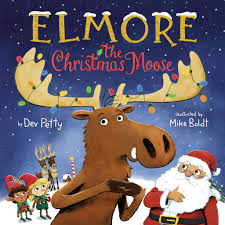Elmore the Christmas Moose

Elmore the Christmas Moose
Once upon a time,
there was a moose...
...with a dream.
Just picture it! Me, Elmore...
one of Santa’s reindeer.
Elmore the Christmas Moose truly begins and concludes with the book’s endpapers that consist of “pages” ostensibly taken from a newspaper’s classifieds section. In the opening set, one entry is circled and enlarged. It reads:
CAREER OPPORTUNITY
*JOB AVAILABLE*
LEAD REINDEER
ON
SANTA’S SLEIGH
APPLY TODAY
In Elmore the Christmas Moose, Santa Claus tells a group of children a story about how the advertisement above came to be filled. The temporary vacancy apparently arose when Prancer had to attend a ventriloquists’ convention. Long aspiring to be part of Santa’s team, even on a temporary, basis, Elmore sends off a letter of application listing his attributes and receives a response inviting him to travel to the North Pole for an in-person interview with Santa. Unfortunately, an attribute that Elmore had failed to mention in his letter that he had simply signed “Elmore M.”, became quite obvious in the pair’s face-to-face meeting; Elmore was a moose, not a reindeer.
Back home, the now rejected moose writes Santa again, acknowledging his not being a reindeer but arguing that “I am a team player and a real people-moose. I know I can do a bang-up job....” Santa, in the spirit of Christmas, decides to give Elmore another interview chance, and so Elmore again travels to the North Pole, but now a shortcoming more significant (and also unmentioned in his earlier letters) becomes apparent. Not only is Elmore not a reindeer, but he can’t fly.
Once again back home, a determined Elmore writes Santa yet a third time, this time asking for one more chance to prove that he can do the job. Santa, who has seen Christmas miracles, such as a reindeer with a glowing nose and a talking snowman, decides to give Elmore a further opportunity at landing the position, saying, “If Elmore believed a moose could fly, why shouldn’t I?”
Unfortunately. Elmore fares no better on his third trip to the Pole, and, upon his return home, he pens a thank-you letter to Santa for the three interviews, and he includes some of his Chocolate Moose Cookies (which contain no moose. Elmore points out) in appreciation. The latter act causes Santa to invite Elmore north for the fourth time, with this visit ultimately leading to a job offer.
Boldt’s cartoon-style illustrations are humorously delightful, and the “hand[hoof?]-printed application letters (signed with a hoof print) add a weird sense of semi-reality to the story. As Santa concludes this story, he tells his listeners, “Maybe next time I’ll tell you the story about the Christmas when we had to hire more elves....”. Turning the page leads to the concluding endpapers, again taken from a newspaper’s classifieds section. This time, however, the highlighted and circled ad is for elf positions as toy designers, candy caners and game players. The “hand” holding the red felt marker appears to be the paw of a polar bear. And so, young readers are wordlessly invited to create their own stories involving this bear’s quest to join Santa’s workshop crew. Hopefully, youngsters will take the time to read all of all of the classified entries in both sets of classifieds as there are some fun ones. In a classroom setting, children could be encouraged to add additional North Pole-themed ads to accompany their elf-wanna-be polar bear tale.
Dave Jenkinson, CM’s editor, lives in Winnipeg, Manitoba, where he sometimes feels like he is at the North Pole.
